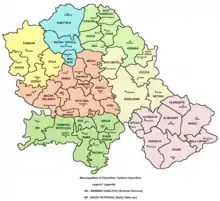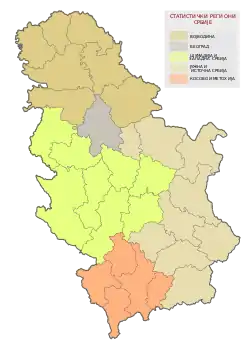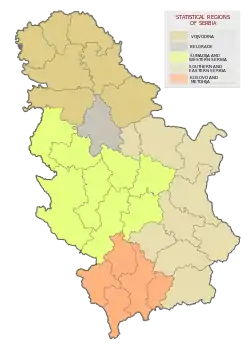Lapovo
Lapovo (Serbian Cyrillic: Лапово) is a town and municipality located in the Šumadija District of central Serbia. The population of the town is 7,837 according to the 2011 census.[3]
Lapovo
Лапово | |
|---|---|
Town and municipality | |
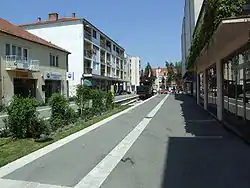 Town center | |
 Coat of arms | |
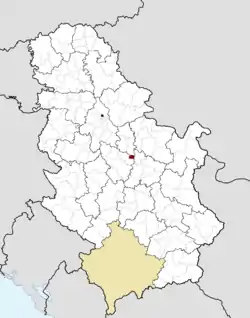 Location of the municipality of Lapovo within Serbia | |
| Coordinates: 44°11′N 21°06′E | |
| Country | |
| Region | Šumadija and Western Serbia |
| District | Šumadija |
| Settlements | 2 |
| Government | |
| • Mayor | Boban Miličić (Srpska napredna stranka) |
| Area | |
| • Municipality | 55 km2 (21 sq mi) |
| Elevation | 105 m (344 ft) |
| Population (2011 census)[2] | |
| • Town | 7,147 |
| • Municipality | 7,837 |
| Time zone | UTC+1 (CET) |
| • Summer (DST) | UTC+2 (CEST) |
| Postal code | 34220 |
| Area code | +381(0)34 |
| Car plates | KG |
| Website | www |
History
The first mention of Lapovo dates from the 12th century when Stefan Nemanja conquered region of Lepenica from Bizanthy.
More accurate information about Lapovo's existence came after the Battle of Kosovo in 1389 while duke Mihailo or MIhalj was running the estate in today’s region of Lapovo.
The Charter of Princess Milica from 1395 mentions landed property of Duke Mihajlo in Hlapova plain, Lapovo today, on the basis of which we can conclude that Lapovo is a village which has a medieval origin. After the liberation from the Turks, a rapid development of Lapovo began, primarily thanks to its favourable geostrategic position. In 1896 Lapovo was declared for the town by decree of King Aleksandar Obrenovic. Municipality of Lapovo is located at Corridor 10, at the intersection of highway Belgrade-Nis. Lapovo also represents one of the most important railway hubs, on the railway line Belgrade-Nis-Athens. Lapovo is currently in a phase of economical development, which is accompanied by the appearance of a large number of national and foreign investors.
Economy
The Lapovo industrial zone has been formed between international highway A1 motorway and railroad tracks, 108 kilometres (67 miles) from Belgrade. Quadrature of the zone is approximately 80 hectares (200 acres) with possibility of further enlargement.
The following table gives a preview of total number of employed people per their core activity (as of 2017):[4]
| Activity | Total |
|---|---|
| Agriculture, forestry and fishing | 11 |
| Mining | 1 |
| Processing industry | 611 |
| Distribution of power, gas and water | 14 |
| Distribution of water and water waste management | 84 |
| Construction | 9 |
| Wholesale and retail, repair | 201 |
| Traffic, storage and communication | 450 |
| Hotels and restaurants | 35 |
| Media and telecommunications | 4 |
| Finance and insurance | 4 |
| Property stock and charter | - |
| Professional, scientific, innovative and technical activities | 36 |
| Administrative and other services | 20 |
| Administration and social assurance | 69 |
| Education | 83 |
| Healthcare and social work | 99 |
| Art, leisure and recreation | 12 |
| Other services | 22 |
| Total | 1,766 |
Notable people
Gallery
 Lapovo City Hall
Lapovo City Hall St. Paraskeve church
St. Paraskeve church Morava river
Morava river Morava river
Morava river
References
| Wikimedia Commons has media related to Lapovo. |
- "Municipalities of Serbia, 2006". Statistical Office of Serbia. Retrieved 28 November 2010.
- "2011 Census of Population, Households and Dwellings in the Republic of Serbia: Comparative Overview of the Number of Population in 1948, 1953, 1961, 1971, 1981, 1991, 2002 and 2011, Data by settlements" (PDF). Statistical Office of Republic Of Serbia, Belgrade. 2014. ISBN 978-86-6161-109-4. Retrieved 27 June 2014.
- Census of Population, Households and Dwellings of the Republic of Serbia page 64
- "ОПШТИНЕ И РЕГИОНИ У РЕПУБЛИЦИ СРБИЈИ, 2018" (PDF). stat.gov.rs (in Serbian). Statistical Office of the Republic of Serbia. Retrieved 16 March 2019.
